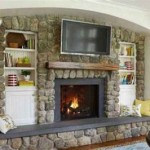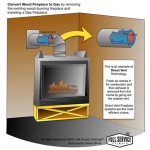Stacked Stone Indoor Fireplace Designs: A Comprehensive Guide
Stacked stone fireplaces have become increasingly popular as a focal point in contemporary and traditional interior design. The natural texture and varied colors of the stone introduce an organic element that complements a wide range of architectural styles. This article will explore various design options for stacked stone indoor fireplaces, considering aspects such as stone selection, installation techniques, and the integration of the fireplace into the overall aesthetic of the living space.
The appeal of a stacked stone fireplace lies in its ability to evoke a sense of warmth, authenticity, and connection to nature. Unlike manufactured materials, each stone possesses unique characteristics, resulting in a fireplace that is inherently one-of-a-kind. The visual depth and textural complexity created by the stacked arrangement contribute to a sophisticated and inviting atmosphere. Furthermore, the durability of natural stone ensures that the fireplace will remain a striking architectural feature for years to come.
Choosing the Right Stone for Your Stacked Stone Fireplace
The selection of stone is paramount to achieving the desired aesthetic for a stacked stone fireplace. Several factors should be considered, including the color, texture, shape, and size of the stones, as well as their overall compatibility with the existing decor. Common stone types used in stacked stone fireplace designs include ledgestone, fieldstone, river rock, and slate. Each type offers a distinct visual impact and textural quality.
Ledgestone, characterized by its thin, rectangular pieces, presents a clean and contemporary look often employed in modern or minimalist designs. Fieldstone, with its irregular shapes and earthy tones, evokes a rustic and traditional ambiance. River rock, with its smooth, rounded surfaces, introduces a more organic and relaxed feel. Slate, known for its layered appearance and often darker hues, lends itself to sophisticated and dramatic designs. The color palette can range from light grays and creams to rich browns, blacks, and even subtle reds and greens, depending on the specific stone variety.
Beyond aesthetics, consider the practicality of the stone. The weight of the stone will influence the structural requirements of the fireplace surround. Porous stones may require sealing to prevent staining. The ease of cutting and shaping the stone will affect the complexity and cost of the installation process. Consulting with a stonemason or fireplace professional is recommended to determine the most suitable stone type for a specific project.
Installation Considerations for Stacked Stone Fireplaces
Proper installation is critical to the structural integrity and visual appeal of a stacked stone fireplace. The process typically involves preparing the fireplace surround, applying mortar to the back of each stone, and carefully positioning the stones to create a tight and visually appealing stack. Grouting may be used to fill in any gaps between the stones, although many designs opt for a dry-stacked appearance, where the stones are fitted together without visible grout lines.
The substrate, or the surface to which the stones are adhered, must be clean, level, and structurally sound. This often involves applying a scratch coat of mortar to a concrete or masonry surface. The type of mortar used should be specifically formulated for stone installations and compatible with the chosen stone type. A staggered joint pattern is commonly used to enhance the structural stability of the stack and create a more visually interesting appearance. Specialized tools, such as masonry saws and chisels, are often required to cut and shape the stones to fit properly around the firebox and other architectural features.
Safety codes and regulations must be strictly adhered to during the installation process. Adequate clearances from combustible materials are essential to prevent fire hazards. A professional fireplace installer will be familiar with these requirements and ensure that the installation meets all applicable standards.
Design Integration and Styling Options
A stacked stone fireplace should be thoughtfully integrated into the overall design of the living space. The style of the fireplace should complement the existing architectural style and decor. In a modern setting, clean lines and minimalist details can be paired with a sleek ledgestone fireplace. In a rustic setting, a fieldstone fireplace with a substantial wooden mantel can create a cozy and inviting atmosphere.
The size and scale of the fireplace should be proportionate to the size of the room. A large fireplace can overwhelm a small space, while a small fireplace may get lost in a large room. The height of the fireplace should also be considered, particularly in rooms with high ceilings. Incorporating built-in shelving, niches, or other architectural details around the fireplace can further enhance its visual impact and functionality.
Lighting plays a crucial role in highlighting the texture and color variations of the stacked stone. Uplighting, downlighting, and accent lighting can be used to create dramatic effects and draw attention to the fireplace as a focal point. Consider the placement of artwork, accessories, and furniture around the fireplace to create a balanced and harmonious composition. The choice of hearth material, such as slate, granite, or concrete, can further complement the stacked stone and enhance the overall aesthetic of the fireplace.

4 Natural Stacked Stone Fireplaces For Your Dream Design

Superb Design Of The Stack Stone Fireplace With White Wooden Bookshelf Added Beige Fabr Stacked Fireplaces Designs Remodel

Pin On Woodworking

Foyer Intérieur Design D Aménagement Avec Parement Pierre Naturelle Inspirationmaison Idma Home Fireplace Brick Makeover Remodel

Natural Stacked Stone Veneer Fireplace Ideas

Natural Stacked Stone Veneer Fireplace Ideas

12 Stacked Stone Fireplace Ideas For Optimal Coziness

Natural Stacked Stone Veneer Fireplace Ideas

Stone Fireplace Design And Remodel

Pin On Home
Related Posts








